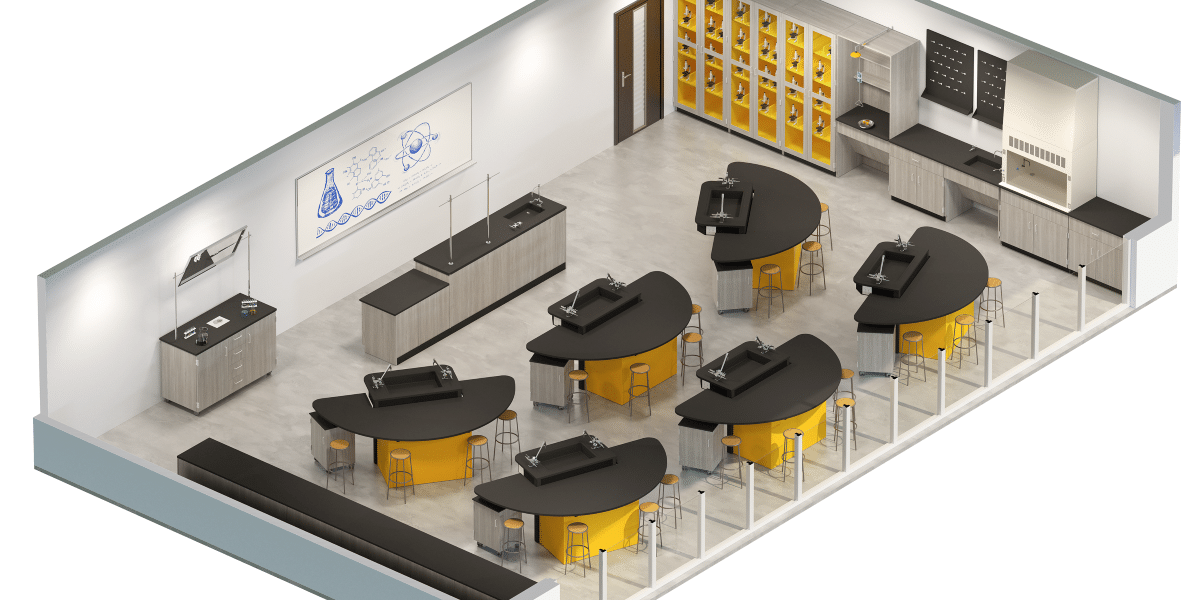By Nina Neuschuetz
A science lab is not just a room with tables and equipment; it is a dynamic space where curiosity and discovery come together.
The design and layout of a science lab can have a significant impact on learning outcomes and safety, so it is vital for educational institutions to optimize these spaces for both teachers and students.
This article explores the key components of designing a science lab that meets the needs of a modern educational setting.
Understanding the Needs of a Science Lab
Science labs are the core of practical science education. The basic requirements for these labs depend on three main principles: safety, functionality, and adaptability.
Educational levels determine the lab’s complexity—what works for a middle school differs greatly from what a high school lab needs.
Different levels need tailored solutions that match the educational complexity and safety requirements suitable for the students’ age and skill levels. Input from the end-users of these spaces, the teachers and students, is invaluable.
Working with educators and learners helps align the design with real-world educational needs and improves the functionality of the lab. Such collaborations ensure that labs are practical and easy to use, creating a positive learning environment.
Key Features of Science Lab Design
Lab Stations
The heart of any science lab is its lab stations. Ensuring these stations are ergonomic and accessible is essential, not only to meet ADA requirements but also to ensure every student can fully engage in lab activities, regardless of their physical abilities.
Lab stations that are height-adjustable offer versatility; they come in various shapes and sizes to accommodate different needs. This adjustability is key, as it allows teachers to effortlessly transition from lectures, where students might be sitting, to experiments, where they generally stand. Consider lab stations that feature electric height adjustments for smooth transitions.
Moreover, some lab stations include integrated sinks, which streamline the cleanup process after experiments. This design prevents the need for students to move across the room to clean up, reducing congestion and wait times at sinks. It’s a thoughtful feature that enhances both safety and efficiency in the lab environment.
Additionally, the work surfaces of these stations must be resistant to chemicals to endure the demands of various experiments without degradation. Suitable materials for these surfaces include chemically resistant laminates or phenolic, both of which are durable and safe choices for an educational setting.
Storage Solutions
Efficient storage solutions are crucial for a functional lab. Proper storage cabinets are necessary to safely house chemicals, sensitive equipment such as microscopes, and student projects. These cabinets should be both easily accessible and securely lockable to safely contain hazardous materials.
Adding small mobile storage cabinets to each work cell can significantly reduce traffic in the classroom, enhancing safety by minimizing the need for students to move around with chemicals or expensive tools. These mobile units can be strategically placed to ensure that everything a student needs is within easy reach, further streamlining lab activities and maintaining a safer learning environment.
Cleaning
As previously mentioned, experiments can be messy, requiring efficient access to sinks so students can easily clean their areas. It is essential to have a sufficient number of sinks, including ADA-accessible options, to accommodate all students.
Additionally, providing drying racks for beakers and other equipment is crucial to maintain order and ensure that tools are ready for their next use.
Safety Features
A comprehensive integration of safety features is vital for any science lab design. Essential elements such as eyewash stations, fire extinguishers, and fume hoods safeguard students and staff from potential accidents.
Additionally, adequate storage for personal protective equipment (PPE) ensures these important safety items are readily accessible when needed. An often overlooked but crucial aspect of safety is the design of walking paths within the lab.
Strategically planning these paths to minimize the distance students need to travel to retrieve or return supplies can significantly reduce the risk of accidents. Ensuring fewer, more direct paths not only keeps the room orderly but also enhances overall safety.
Technology Integration
In today’s educational landscape, a modern science lab must have adequate provisions for power and internet connectivity. Power plugs should go where wires won’t interfere with an experiment.
Layout Considerations
The layout of a science lab significantly influences its functionality and safety. Zoning is a strategic approach that separates the lab into distinct areas—work areas, storage, and a dedicated teacher demonstration zone. Each zone serves a specific function, optimizing the lab’s overall flow and utility.
Traffic flow within the lab should be seamless to reduce congestion and enhance accessibility. This not only improves safety but also ensures that students can move freely and efficiently during experiments.
Flexibility is another critical aspect, allowing spaces to adapt quickly from lecture settings to hands-on experimental setups at the push of a button. This adaptability makes it possible to utilize the lab for various teaching methods and learning activities, maximizing the use of the space.
Designing an effective science lab is a complex but rewarding challenge that plays a crucial role in education.
By focusing on the key principles of safety, functionality, adaptability, and technology integration, educational institutions can create environments that inspire and facilitate scientific exploration and discovery.
As schools look to the future, investing in well-designed science labs is not merely an enhancement to their infrastructure but a foundational step towards fostering the next generation of scientists, researchers, and innovators.
Nina Neuschuetz serves as the marketing manager at Case Systems, a premier national provider of innovative workstation and storage solutions tailored for K-12 educational environments, www.casesystems.com.










